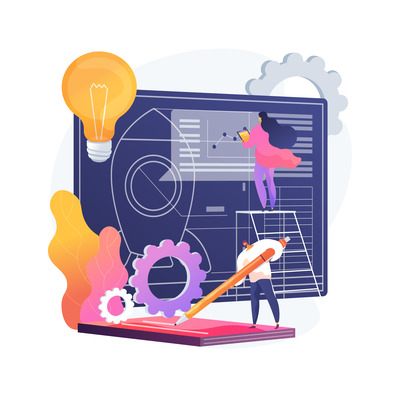Product Engineering & Development
Contact UsSoftware product development
Product engineering and development refers to the process of designing, creating, and bringing a new product to market. This encompasses a wide range of activities, including conceptualization, design, prototyping, testing, and production. It is a multidisciplinary approach that involves various teams and expertise to turn innovative ideas into real-world products. Here's a short description of how product engineering and development work and how one can contribute to its success.
How Product Engineering & Development Works:
Software product development is a comprehensive process that involves multiple stages, each playing a crucial role in bringing a concept to life and ensuring its success in the market. Here is a narrative version of the process.

1. Idea Generation and Conceptualization:
The journey begins by recognizing a market need, identifying a problem that needs solving, or spotting an opportunity for innovation. This initial spark is the foundation upon which software products are built. It sets the stage for brainstorming ideas and forming a solid concept.
2. Market Research:
Before diving into development, it's essential to conduct thorough market research. This phase involves delving deep into customer needs, understanding the competitive landscape, and gauging potential demand for the product. It refines the initial concept and narrows down the target audience.
3. Planning and Requirement Analysis:
With a clear understanding of the market and user expectations, detailed planning takes center stage. This phase defines the project's scope, objectives, and requirements. The project team maps out a roadmap, creates a project timeline, and allocates necessary resources to ensure a smooth development process.
4. Design and Architecture:
The design and architecture phase brings the software to life on paper. Software architects engineer the system's high-level structure, laying the groundwork for its functionality and performance. Concurrently, user interface (UI) and user experience (UX) designers work on crafting the product's visual and interactive elements, ensuring a seamless user experience.
5. Development:
The heart of the development process, this stage involves developers translating design and architecture into functional code. They create database structures, integrate various components, and implement the features outlined in the project plan. Agile or Scrum methodologies are often employed to manage development efficiently and adapt to changing requirements.
6. Testing and Quality Assurance:
Rigorous testing is a critical step to ensure the software's reliability and functionality. It involves identifying and rectifying any bugs or issues that may have arisen during development. Quality assurance measures are in place to guarantee that the product meets performance, security, and reliability standards.
7. Deployment and Release:
The culmination of development leads to the deployment of the software to a production environment, making it accessible to users. Initial users or beta testers may have the opportunity to provide feedback, which serves as valuable input for further improvements.
8. Maintenance and Updates:
Software products are not static entities; they require continuous attention and improvement. The maintenance phase involves ongoing updates, bug fixes, and enhancements based on user feedback and evolving requirements. New features are introduced over time to keep the product competitive and up to date.
9. Marketing and Launch:
To introduce the software to the world, a well-executed marketing strategy is essential. Launch activities include press releases, website launches, and social media campaigns. These efforts aim to generate awareness and excitement around the product.
10. Customer Support:
After the launch, customer support teams came into play. They assist users with inquiries, troubleshoot issues, and provide technical assistance. Valuable feedback from users informs further product improvements, ensuring that the software continues to evolve and meet the changing needs of its user base.
-
(i) Idea Generation
The process begins with identifying a market need, problem, or opportunity. Creative ideas are brainstormed, often based on customer feedback and market researc
-
(ii) Conceptualization
The selected idea is refined into a product concept. This includes defining the product's purpose, target audience, features, and value proposition.
-
(iii) Feasibility Analysis
A feasibility study is conducted to assess the technical, financial, and operational aspects of the project. This helps determine whether the concept is viable
-
(IV) Design and Prototyping
Detailed design and prototyping are critical steps. Engineers and designers create a blueprint of the product, including its architecture, components, and user interface.
-
(V) Development
Developers write the code, build the hardware, or create the physical product based on the design specifications. Agile methodologies are often employed for flexibility and efficiency.
How Can We Help

1. Engineering Expertise:
We provide a team of skilled engineers and developers to bring your product concept to life. Whether it's software, hardware, or a combination of both, our experts have the technical knowledge to execute your vision
2. Design and Prototyping:
Our design and prototyping services help you transform ideas into tangible product designs. We focus on user-centric design principles to create intuitive and visually appealing products.
3. Project Management:
Efficient project management ensures that development stays on track, within budget, and meets deadlines. We offer project managers to oversee the entire process
4. Quality Assurance:
Our quality assurance teams conduct comprehensive testing to ensure your product functions correctly, is reliable, and meets industry standards.
5. Manufacturing Support:
For physical products, we provide guidance and support in sourcing materials, selecting manufacturing partners, and ensuring quality control.
Product engineering and development can encompass various types of products, each with its unique challenges and requirements. Here are some common types of product engineering and development:
Software Product Development
Software product development is the process of conceptualizing, designing, building, and launching software applications or products for a specific market or user base. It involves a systematic approach to creating software solutions that meet user needs, adding value, and often includes ongoing maintenance and updates.
Customized Software Development
Customized software development refers to the creation of bespoke software applications tailored to the specific requirements and needs of a business or organization. These solutions are designed to address unique challenges and provide a competitive advantage by aligning software functionalities closely with the organization's goals.
Application Development
Application development, often referred to as app development, encompasses the creation of software applications for various platforms, including web, mobile, and desktop. It involves the entire software development lifecycle, from initial planning and design to coding, testing, and deployment.
Application Modernization
Application modernization is the process of updating and enhancing existing software applications to make them more efficient, user-friendly, and compatible with modern technologies. This often involves migrating legacy applications to newer platforms or architectures while preserving essential functionalities.
Custom API Development
Custom API (Application Programming Interface) development involves creating application interfaces tailored to specific software systems or services. APIs enable different software applications to communicate and share data, and custom APIs are designed to meet the unique integration needs of a business.
Custom Android App Development
Custom Android app development focuses on creating unique, tailored mobile applications for the Android platform. These apps are designed to address specific business requirements, offer a seamless user experience, and leverage the capabilities of Android device.
Custom iOS App Development
Custom iOS app development involves the creation of bespoke mobile applications for Apple's iOS platform, which powers iPhones and iPads. Custom iOS apps are crafted to meet the precise needs of businesses and deliver a high-quality experience to iOS users.
Read more blogs here
